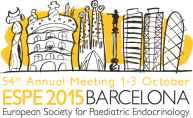
54th Annual ESPE
Barcelona,
Spain
01 Oct 2015 - 03 Oct 2015
hrp0084p1-12 | Bone | ESPE2015
Genetic Diagnosis Using Whole Exome Analysis in Two Cases with Malign Infantile Osteopetrosis
Demir Korcan , Nalbantoglu Ozlem , Karaer Kadri , Korkmaz Huseyin Anil , Yildiz Melek , Tunc Selma , Ozkan Behzat
hrp0084p1-13 | Bone | ESPE2015
Osteogenesis Imperfecta: A Pilot Trial on Treatment with the RANKL-Antibody Denosumab
Hoyer-Kuhn Heike , Netzer Christian , Hero Barbara , Schoenau Eckhard , Semler Oliver
hrp0084p1-14 | Bone | ESPE2015
No Secular Trend in Vitamin D Levels Over the Past 30 Years in Swedish Children
Andersson Bjorn , Albertsson-Wikland Kerstin , Swolin-Eide Diana , Magnusson Per
hrp0084p1-15 | Bone | ESPE2015
Lithium Chloride Prevents Glucocorticoid-Induced Growth Failure in Cultured Foetal Rat Metatarsal Bones
Soucek Ondrej , Zaman Farasat , Savendahl Lars
hrp0084p1-16 | Bone | ESPE2015
Diverse Presentations of Hypophosphatasia in Paediatric Patients: A Review of the Case Literature
Sawyer Eileen K , Anderson Karen
hrp0084p1-17 | Bone | ESPE2015
Humanin Prevents Undesired Apoptosis of Chondrocytes without Interfering with the Anti-Inflammatory Effect of Dexamethasone in a Model of Arthritis
Sederquist Bettina , Aulin Cecilia , Zaman Farasat , Savendahl Lars
hrp0084p1-18 | Bone | ESPE2015
Response to Vitamin D Replacement is Determined by Body Surface Area in Children with Vitamin D Deficiency
Chung In Hyuk , Kang Yu Sun , Yoo Eun-Gyong
hrp0084p1-19 | Bone | ESPE2015
Bone–Muscle Unit Assessment with pQCT in Children with Inflammatory Bowel Disease Following Treatment with Infliximab
Altowati Mabrouka , Malik Umm-Ie-Salma , Shepherd Sheila , Mcgrogan Paraic , Russell Richard , Ahmed Faisal , Wong S C
hrp0084p1-20 | Bone | ESPE2015
24-Hydroxylase Polymorphism as a Possible Contributor to the Increased 1,25(OH)2D in African Americans
Carpenter Thomas O , Cole David E C , Ardeshirpour Laleh , Salehpour Shadab
hrp0084p1-21 | Bone | ESPE2015
Effects of Inorganic Phosphate and FGF23 on C2C12 Myoblast Cells
Raimann Adalbert , Dangl Alexander , Greber-Platzer Susanne , Egerbacher Monika , Haeusler Gabriele
hrp0084p1-22 | Bone | ESPE2015
Evaluation of Bone Mineral Density and Microarchitectural Parameters by DXA and HR-PQCT in 36 X-linked Hypophosphatemic Rickets Patients from a Single-Centre Study
Neto Guido de Paula Colares , Pereira Rosa Maria Rodrigues , Alvarenga Jackeline Couto , Takayama Liliam , Funari Mariana Ferreira de Assis , Martin Regina Matsunaga



